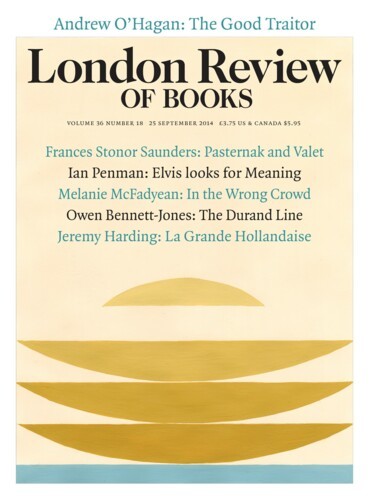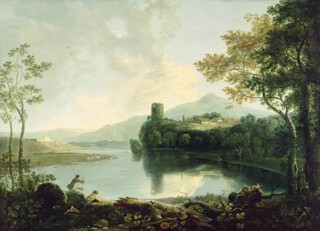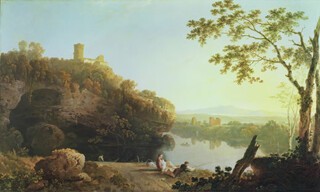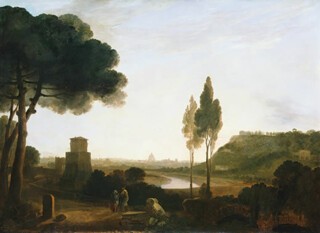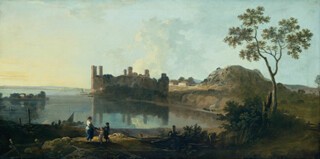The National Museum of Wales is currently staging a large loan exhibition of the Welsh ‘father of English landscape’, Richard Wilson, curated by Martin Postle and Robin Simon. It is a magnificent show, the first on this scale for more than thirty years. It will be at Cardiff until 26 October, and it is accompanied by a sumptuous catalogue, the fullest, most faithfully reproduced collection of colour reproductions of Wilson’s painting there will ever be in book form, accompanied by a collection of scholarly essays that is on the whole disappointing.* Wilson was as exciting a painter of landscapes as his near contemporary Gainsborough, as influential on Constable as Gainsborough was, and the most important British predecessor of Turner. Many of the best British landscape painters of the generation after his were trained in his London studio, including William Marlow, Joseph Farington and, best of all, Thomas Jones and William Hodges. Unlike Gainsborough, who took off from the tradition of Dutch landscape painting, in Rome Wilson became a follower of the school of Claude Lorrain, more classically Arcadian in its subjects and atmosphere, more expansive in its distances. ‘You may walk in Claude’s pictures and count the miles,’ Wilson declared, but to my eye his management of distance is superior to Claude’s, more subtle in its tonal range and aerial perspective.
The relative qualities of the two painters gave rise to much discussion in the last decades of the 18th century, before Wilson came to be forgotten. The portrait painter John Hoppner, an early adherent of the Joey-Barton-on-Question-Time school of cultural criticism, declared that ‘considering the qualities of Claude & Wilson as He shd. the qualities of two fine Women, He should acknowledge the beauties of Claude but say Wilson was a piece of more relish.’ I’m embarrassed to say that I think I know what he means: what gives me most pleasure in Wilson’s paintings is the combination of the tactility of his foregrounds – rocks, roads, the bark of trees – and a weightless delicacy, for example in the transparency of his foliage against the sky. In Wilson’s pictures, Constable remarked, ‘objects appear floating in sunshine.’
I have been looking forward to this new Wilson exhibition, not just for the pleasure of the pictures on show, but to see how it would comment on the furore that greeted the last major Wilson exhibition, Richard Wilson: The Landscape of Reaction, curated by David Solkin, now of the Courtauld Institute, certainly the best, and probably the most respected, historian of 18th-century British art now practising. In the introduction to his excellent and, as it turned out, controversial catalogue, Solkin had suggested that the popularity of Wilson in the 18th century derived from his willingness to represent the landscapes of Italy and Wales as Arcadian places of untroubled social harmony, inhabited by happy peasants with little apparent obligation to labour and with plenty of time for quiet fun. His landscapes, like those of most of his contemporaries, ‘both glamorised the prevailing structure of power and made its obvious inequities look simply like part of nature’. This was not an account of British landscape art that in 1982 the art-historical establishment wanted to hear. For them, Wilson’s landscapes were about the beauty of nature, superbly and ‘sincerely’ represented, without the slightest taint of ideology. Nor could they grasp the notion that Solkin could believe such awful things about Wilson at the same time as greatly admiring his paintings.
Denys Sutton, the editor of Apollo, was the loudest and loopiest in condemnation of this example of what he denounced as ‘Marxist infiltration’. In an editorial which is now a pure joy to read, though I doubt if it seemed so to Solkin at the time, Sutton warned his readers that one consequence of this Marxist approach to Wilson was that it would ‘inevitably’ condition the minds of some of its readers into ‘accepting the policies of the Soviet regime’. With Russia now led by Yuri Andropov, an ex-chairman of the KGB, ‘infiltration will assume a more subtle and insidious form and an increasingly determined effort will be made to court the intellectuals, often only too prone to flattery.’ The directors of national museums like the Tate, he warned, had therefore better be much more vigilant in their efforts to keep left-wing ideas out of their publications, for ‘if some measure of self-policing (or self-discipline) is not instituted, their ostensible masters may be obliged to take a more active role in the management of those institutions which, nominally at any rate, are in their charge.’
The Daily Telegraph too devoted an editorial, no less, to the exhibition, and if it now seems incredible that it should take that much notice of an exhibition of a long-dead artist whom few of its readers would have heard of, it seemed equally incredible then. But the editorial justified its intervention by asserting that ‘millions’ of people have ‘revered’ Wilson’s work, and that to them ‘this ugly picture of the artist as a cynic assisting “landed patricians” to the “domination of culture” will seem a craven distortion.’ Ruskin, the editorial declared, would have been particularly appalled by what Solkin had written, and there it may well be right, since Ruskin took a much tougher line than Solkin with the Arcadian landscapes that were among Wilson’s specialisms. They depicted, Ruskin declared, a mode of life dependent on slavery, ‘the command … of a higher order of men over a lower, occupied in servile work’, and ‘the resolute degradation of the lower orders’.
In an essay of 1994 on the historiography of British 18th-century art, the art historian Michael Kitson, whom no one ever suspected of being Andropov’s creature, looked back on Solkin’s exhibition a decade after the event and described the responses to it as ‘ridiculous’. ‘It is a striking fact,’ he remarked, that ‘no effective counterblast’ to Solkin’s argument – that the history of art ‘is the process of tracing the interaction of visual imagery with ideology and political and social history’ – had yet been written. The opposition had been ‘substantially defeated’, so much so that 12 years later it was ‘not easy to understand what all the fuss was about’. Solkin’s approach to Wilson, which of course had nothing to do with representing Wilson as a ‘cynic’, is now ‘common sense’, one reviewer of the Cardiff show writes; another quotes Solkin on Wilson’s ability to transform ‘patrician mythology into persuasive landscape form’, and adds that this ‘might well be taken as the starting point’ for the new exhibition. In fact, however, the index to the new catalogue contains only one reference to Solkin, and the curators evidently have no interest in engaging with what is, even thirty years after it was written, the fullest as well as the most challenging account we have of Wilson’s work. They do however have an argument of their own to advance.
As you enter the exhibition, this argument is set out on an information board displayed beneath Anton Raphael Mengs’s wonderful portrait of Wilson painting in Italy. ‘Richard Wilson,’ the first paragraph declares, ‘trained and worked as a portrait painter in 18th-century London. Then, in 1750, he went to Italy for almost seven years. Once he arrived in Rome, he decided to concentrate on landscapes. This change of career was to transform landscape painting in Europe.’ This is an odd beginning: the exhibition is devoted to, by common consent, the greatest painter to have come out of Wales, held in Wales’s national gallery, and yet no mention is made of Wilson’s Welshness, nor will it be in the remaining paragraphs. It is as if the wildly inflated claim that Wilson ‘transformed’ European landscape painting – a claim repeated in one form or another throughout the show and the catalogue – can only be given even a touch of credibility by passing him off as a Londoner, or at least not as a mere Welshman. In the final paragraph we learn, however, that he did do some painting in Wales, but then so did virtually every English landscape artist who came after him.
The exhibition does not base its claim on works by European painters that show the apparent signs of Wilson’s transformative influence. Indeed, the curators do not seem to have found any painters from outside Britain whose painting was transformed by their encounter with Wilson. The only non-British artist whom the exhibition shows to have been decisively influenced by him is the little-known German Adolf Friedrich Harper, but the case rests almost entirely on his drawings, eight or nine of which appear in the show, some of them copies of drawings by Wilson. Only one of Harper’s paintings is exhibited, Landscape with Ruins, made some forty years after Wilson had left Rome. It is pleasantly neat and clearly Wilsonian in manner: the catalogue represents it as deriving from Wilson’s Solitude, a superb landscape of 1762, though I cannot see any strong relationship between the two. Either way it is hardly enough, even taken with the similar drawings on show by other non-British artists in Rome, to make the case for Wilson’s decisive influence on European landscape painting.
That case turns out not to depend on the evidence of actual paintings by European artists. Wilson, the argument seems to be, attracted to his studio in Rome a number of artists of various nationalities whom he taught partly by setting them to copy his own landscape drawings, but also, crucially, by leading groups of them into the landscapes round Rome to draw directly from nature. He taught them, in short, what he had himself apparently learned about landscape while in Rome: to turn away from painting ‘invented compositions’ of the kind preferred by Lorrain and Gaspard Dughet, in favour of views of real places. ‘He studied the places around Rome from which they had drawn inspiration, and realised that he could remain true to a specific location, rather than seeking to create an ideal that did not exist in nature.’ He painted – though the evidence for this does not seem to me very strong – plein-air oil sketches, recording the colour and tone, even the atmospheric conditions, of particular landscapes as drawings could not do. It was this discovery, of the value of drawing and painting directly from the motif, that enabled Wilson to accomplish the transformation of European landscape painting.
The argument would be more convincing if the curators had taken more trouble to establish that many of the landscapes Wilson painted of views near Rome really were, as they put it, ‘true to nature’, true to ‘specific locations’. A few years ago I spent several days driving around the Castelli Romani, and up as far as Tivoli, with Solkin’s catalogue and W.G. Constable’s book on Wilson in the car, but though I could find plenty of individual features that Wilson included in his landscapes, I couldn’t find any extended views to which his landscapes seemed to have been substantially ‘true’. That may simply have been my obtuseness; but in a catalogue in which so much is staked on Wilson’s painting real, not imaginary views, perhaps some photographs would have helped. It might also have been appropriate to have acknowledged that before he ever went to Italy Wilson had been painting ‘specific locations’ in Britain – Dover, Caernarvon Castle, Cheam Common and so on – and to have discussed how such pictures affected the central claim of the exhibition. Oddly, however, none of the landscapes Wilson painted before he went to Italy is included in the exhibition or discussed in the catalogue, except by Kate Lowry in her excellent essay on Wilson’s methods and materials. Their absence from the exhibition may amount to a silent acknowledgment of the obvious complications they would raise for a thesis that places so much emphasis on the time Wilson spent in Rome as the central, formative period in his artistic development and influence.
In the end, however, it is an essay in the catalogue by Lars Kokkonen that seems most effectively to question that thesis. It examines the influence of Claude-Joseph Vernet, Wilson’s exact contemporary, on the landscapes Wilson painted in Rome. It was Vernet who encouraged him to give up portrait painting to concentrate on landscape; it was Vernet, or so it seems to be generally agreed, who pioneered plein-air oil painting in 18th-century Italy; and it was the French Academy in Rome, to which Wilson had access through Vernet, that initiated the practice of taking students on plein-air sketching trips in the environs of Rome. Wilson, Kokkonen proposes, ‘found his lodestar in Vernet and, through him, a connection with the French landscape tradition’. Kokkonen quotes a remark by Marianne Roland Michel: ‘the status of landscape painting was totally transformed by the appearance of a new type of landscape painter – of which Joseph Vernet was the model incarnate – and by the enthusiastic reception of his work by both critics and the public.’ In short, the honour of being recognised as the transformer of European landscape, if it belongs to anyone, is Vernet’s. He was described in his lifetime as ‘fundamentally changing the nature of landscape painting’. If the point of the exhibition is to challenge this remark, the curators should surely have engaged with it directly.
The impression left by the catalogue and the information boards in the exhibition is that, except in one or two cases, no one working on Wilson these days has much to say to us, though they have much by way of little notes and queries to say to each other. In an essay in History Workshop Journal at the time of Solkin’s show, Neil McWilliam and Alex Potts congratulated Solkin for ‘setting to one side the well-worn art-historical discussions about the balance between naturalism and classicism in Wilson’s landscapes’. The last sentence of that first information board at Cardiff, the one that sums up Wilson’s career and the argument of the whole show, tells us that ‘in painting heroic landscapes that were also true to nature, Wilson laid the foundations of the romantic landscape art of John Constable and J.M.W. Turner.’ This then turns out to be the new big question about Wilson: is his painting ‘true to nature’ and classic, or true to nature and Romantic? The more some art history seeks to change, the more it remains the very same thing.
Send Letters To:
The Editor
London Review of Books,
28 Little Russell Street
London, WC1A 2HN
letters@lrb.co.uk
Please include name, address, and a telephone number.
